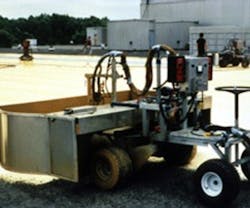Year in and year out, it has been estimated that two-thirds of all commercial roofing activity is related to reroofing and re-cover rather than new construction.
Decisions on what, when, and where to reroof may be based in part on leakage, although timing may also be related to an overall corporate financial plan (spend it now because funds may not be available later).
The choices for reroofing are generally categorized as:
- Traditional bituminous built-up roofing
- Polymer-modified bituminous roofing
- Single ply polymeric roofing
- Metal roofing panels
- Sprayed-in-place polyurethane foam (SPF)
Three Considerations for Foam
A sprayed-in-place foam solution for reroofing might be the best choice for you if:
1) Your existing roof already has two membranes, in which case it has already met the maximum permitted by building code. However, SPF is extremely light (less than 1 pound per square foot) and is usually exempted from that code limitation. If the existing roof is surfaced with gravel or ballast, removal of that surfacing and replacement with SPF will actually reduce some of the dead load on the structure.
2) The existing roof system is aged, which typically means it is under-insulated. One inch of wood fiber or perlite board would have an R-factor of 2.8, so applying two inches of SPF on top would add 11.2 (in•h•ft2/BTU), and substituting a reflective coating on the foam, compared to a dark-colored gravel, would reduce air conditioning load as well.
3) The system is fully adhered. Many single ply roof systems are partially fixed to the structural roof deck, especially those using mechanical fasteners. These systems may flutter and balloon under high wind load. SPF systems are fully adhered to the substrate and can serve as an air barrier as well as the roof membrane. See Building Science.com BSI-019 Uplifting Moments—Roof Failures, Joseph Lstiburek, 2009PageBreak
Key Advantages
Still not sure whether to go with SPF? The material offers these important properties:
Richard (Dick) L. Fricklas was technical director emeritus of the Roofing Industry Educational Institute prior to his retirement. He is co-author of The Manual of Low Slope Roofing Systems, and continues to participate in seminars for the University of Wisconsin and RCI Inc., the Institute of Roofing, Waterproofing, and Building Envelope Professionals. His honors include the Outstanding Educator Award from RCI, William C. Cullen Award and Walter C. Voss Award from ASTM, the J. A. Piper Award from NRCA, and the James Q. McCawley Award from the MRCA. Dick holds honorary memberships in both ASTM and RCI Inc.
Maintenance and application considerations: Roofs do get damaged while in service. If the foam and/or coating get punctured, this does not result in an immediate leak. Maintenance may require nothing more than removing collected debris from a puncture and pumping a compatible caulk, such as silicone with silicone coating, to fill in the cavity.
SPF systems also require very little tack-free time. This refers to the time the foam is dry to the touch. It can then be sprayed over with another layer of mixed chemicals, and with some care, be walked on. All lifts should be applied in a single day, and a base coat of protective elastomer should be applied as well.
Cure time refers to the time required for the foam to reach its maximum physical properties. Within the first hour of application, the foam will reach 90% of its cure and at least 90% of its maximum physical properties.
SPF can be directly applied to BUR surfaces that have been wet-vacuumed and allowed to dry. Wet insulation or cover boards need to be removed and replacement material installed to make the surfaces level to receive the new foam system.
With most single-ply roof systems, the partially attached or ballasted roof systems can be removed and recycled, then new cover board installed, followed by the new SPF system. SPF can also be directly applied to metal roof panels. Modified bituminous roof systems are generally fully adhered and can be treated much like BUR systems.
Sustainable qualities: SPF systems are LEED advantaged when considering transportation. The volume of the liquid components expands 30 times during application, from 62 pounds per cubic foot when it leaves the factory to 2 pounds per cubic foot after the blowing agent does its job on site.
Sustainability has taken on new meaning in the past few decades. SPF systems should be recoated when the elastomeric surface coating first starts to erode. When done promptly, the roof system can last indefinitely. If the coating has been neglected, it may be necessary to scarify the pin-holed coating and some depth of the foam itself and follow this with at least one more lift of SPF.
For more information, see the Spray Polyurethane Foam Alliance for excellent literature on SPF systems, obtain a copy of ASTM D7425-11, or check out this informative video.
Quick Fixes for Sprayed Polyurethane Roof Systems
Tips and tricks for repairing SPF damage.
Spray on the Savings
How to evaluate SPF’s viability for your roof.
Roof Fastener Guide
Repairing or reroofing an older property? Check out our guide to fastener technology.
About the Author
Richard L. Fricklas
Richard (Dick) L. Fricklas received a Lifetime Achievement Award and fellowship from RCI in 2014 in recognition of his contributions to educating three generations of roofing professionals. A researcher, author, journalist, and educator, Fricklas retired as technical director emeritus of the Roofing Industry Educational Institute in 1996. He is co-author of The Manual of Low Slope Roofing Systems (now in its fourth edition) and taught roofing seminars at the University of Wisconsin, in addition to helping develop RCI curricula. His honors include the Outstanding Educator Award from RCI, William C. Cullen Award and Walter C. Voss Award from ASTM, the J. A. Piper Award from NRCA, and the James Q. McCawley Award from the MRCA. Dick holds honorary memberships in both ASTM and RCI Inc.

